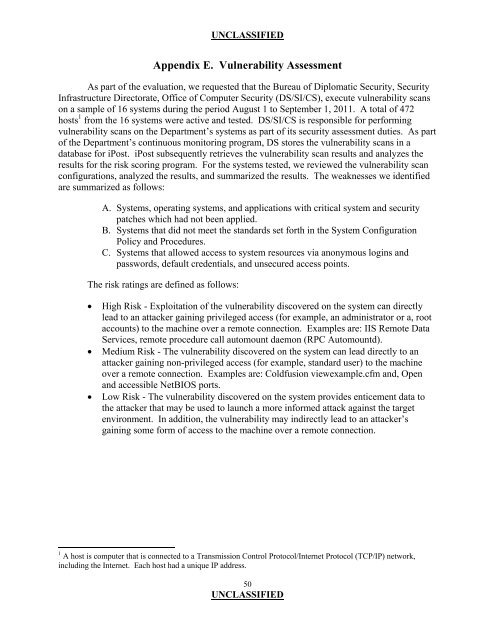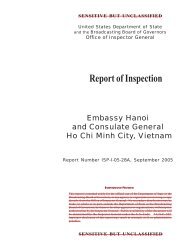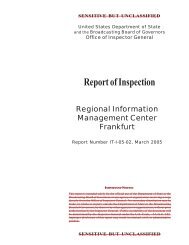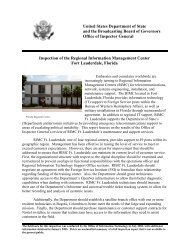Evaluation of Department of State Information Security Program ...
Evaluation of Department of State Information Security Program ...
Evaluation of Department of State Information Security Program ...
You also want an ePaper? Increase the reach of your titles
YUMPU automatically turns print PDFs into web optimized ePapers that Google loves.
UNCLASSIFIED<br />
Appendix E. Vulnerability Assessment<br />
As part <strong>of</strong> the evaluation, we requested that the Bureau <strong>of</strong> Diplomatic <strong>Security</strong>, <strong>Security</strong><br />
Infrastructure Directorate, Office <strong>of</strong> Computer <strong>Security</strong> (DS/SI/CS), execute vulnerability scans<br />
on a sample <strong>of</strong> 16 systems during the period August 1 to September 1, 2011. A total <strong>of</strong> 472<br />
hosts 1 from the 16 systems were active and tested. DS/SI/CS is responsible for performing<br />
vulnerability scans on the <strong>Department</strong>’s systems as part <strong>of</strong> its security assessment duties. As part<br />
<strong>of</strong> the <strong>Department</strong>’s continuous monitoring program, DS stores the vulnerability scans in a<br />
database for iPost. iPost subsequently retrieves the vulnerability scan results and analyzes the<br />
results for the risk scoring program. For the systems tested, we reviewed the vulnerability scan<br />
configurations, analyzed the results, and summarized the results. The weaknesses we identified<br />
are summarized as follows:<br />
A. Systems, operating systems, and applications with critical system and security<br />
patches which had not been applied.<br />
B. Systems that did not meet the standards set forth in the System Configuration<br />
Policy and Procedures.<br />
C. Systems that allowed access to system resources via anonymous logins and<br />
passwords, default credentials, and unsecured access points.<br />
The risk ratings are defined as follows:<br />
� High Risk - Exploitation <strong>of</strong> the vulnerability discovered on the system can directly<br />
lead to an attacker gaining privileged access (for example, an administrator or a, root<br />
accounts) to the machine over a remote connection. Examples are: IIS Remote Data<br />
Services, remote procedure call automount daemon (RPC Automountd).<br />
� Medium Risk - The vulnerability discovered on the system can lead directly to an<br />
attacker gaining non-privileged access (for example, standard user) to the machine<br />
over a remote connection. Examples are: Coldfusion viewexample.cfm and, Open<br />
and accessible NetBIOS ports.<br />
� Low Risk - The vulnerability discovered on the system provides enticement data to<br />
the attacker that may be used to launch a more informed attack against the target<br />
environment. In addition, the vulnerability may indirectly lead to an attacker’s<br />
gaining some form <strong>of</strong> access to the machine over a remote connection.<br />
1 A host is computer that is connected to a Transmission Control Protocol/Internet Protocol (TCP/IP) network,<br />
including the Internet. Each host had a unique IP address.<br />
50<br />
UNCLASSIFIED








